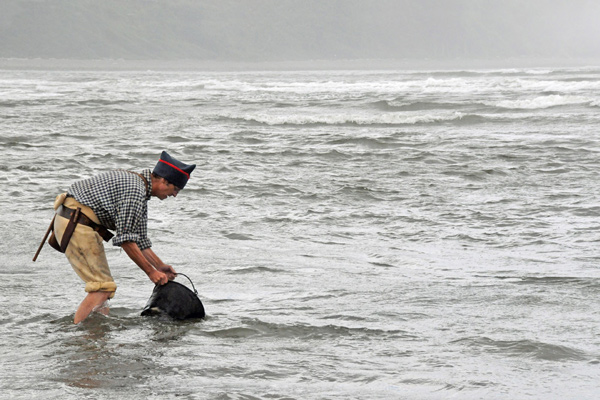Fort Clatsop, Astoria, OR Two new salt makers are sent to the salt works to replace sick men, and Lewis describes the Pacific blackberry and evergreen huckleberry. In Washington City, President Jefferson shares the progress of three Western expeditions.
Two New Salt Makers
Sergt. Pryor and five men Set out with a canoe to go round to the Salt works after the Sick men. 2 more men were to Stay in their places three men went out to hunt.
—John Ordway
Pacific Blackberry
here is a shrub which grows commonly in this neighbourhood which is precisely the same with that in Virginia some times called the quillwood . . . . it is much branched the bark of a redish brown colour and is covered with a number of short hooked thorns which renders it extreemly disagreeable to pass among
—Meriwether Lewis
Evergreen Huckleberry
The[re] is also found in this neighbourhood an evergreen shrub which I take to be another variety of the Shallun . . . . the natives eat this berry when ripe but seldom collect it in such quantities as to dry it for winter uce.—
—Meriwether Lewis
Early Specimens
Washington Feb. 11. 1806.
Dear Sir
with his map he sent us specimens or information of the following animals not before known to the Northern continent of America. 1. the horns of what is perhaps a species of the Ovis Ammon [bighorn sheep]. 2. a new variety of the deer having a black tail [mule deer]. 3. an Antelope [pronghorn]. 4. the badger, not before known out of Europe. 5. a new species of Marmotte [prairie dog]. 6. a white weasel. 7. the magpie. 8. the Prairie hen, said to resemble the Guinea-hen (Peintade) [sharp-tailed grouse] 9. a prickly Lizard [short-horned lizard]. to these are added a considerable collection of minerals, not yet analysed.
Th: Jefferson[1]“From Thomas Jefferson to Constantin François Chasseboeuf Volney,” Founders Online, National Archives, [founders.archives.gov/documents/Jefferson/99-01-02-3220. [An Early Access document … Continue reading
Western Explorers
having been disappointed in our view of sending an exploring party up the Red river the last year, they were sent up the Washita, as far as the Hotsprings, under the direction of mr Dunbar.
. . . . .
our party is just at this time setting out from Natchez to ascend the Red river. these expeditions are so laborious, & hazardous, that men of science, used to the temperature & inactivity of their closet, cannot be induced to undertake them. they are headed therefore by persons qualified expressly to give us the geography of the rivers with perfect accuracy, and of good common knolege & observation in the animal, vegetable & mineral departments. when the route shall be once open & known, scientific men will undertake, & verify & class it’s subjects.
Th: Jefferson [2]“Jefferson to Volney,” Founders Online.
Weather Diary
aspect of the weather at rise
Wind at rise
aspect of the weather at 4 OC1 P.M. Wind at 4 O’Clock P.M. cloudy after fair & cloudy S W rain after fair & rain S W. —Meriwether Lewis[3]To assist the reader, the editor of this web page has omitted the “Day of ye Month” column and spelled out some abbreviations.
Fort Clatsop is a High Potential Historic Site along the Lewis and Clark National Historic Trail managed by the U.S. National Park Service. The site is managed by the Lewis and Clark National and State Historic Parks.
Notes
| ↑1 | “From Thomas Jefferson to Constantin François Chasseboeuf Volney,” Founders Online, National Archives, [founders.archives.gov/documents/Jefferson/99-01-02-3220. [An Early Access document from The Papers of Thomas Jefferson.] Also in Letters of the Lewis and Clark Expedition with Related Documents: 1783-1854, 2nd ed., ed. Donald Jackson (Urbana: University of Illinois Press, 1978), 291. |
|---|---|
| ↑2 | “Jefferson to Volney,” Founders Online. |
| ↑3 | To assist the reader, the editor of this web page has omitted the “Day of ye Month” column and spelled out some abbreviations. |



